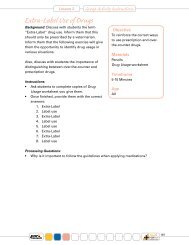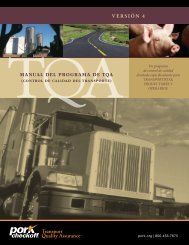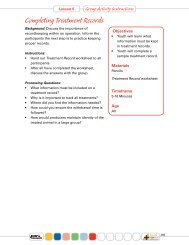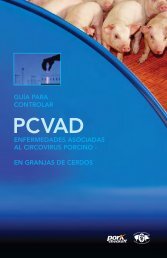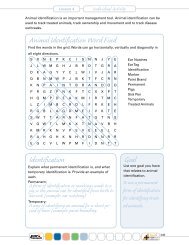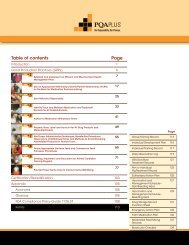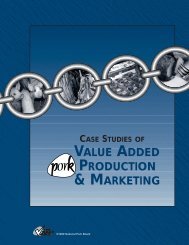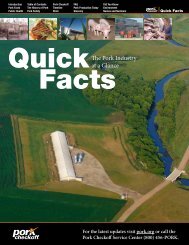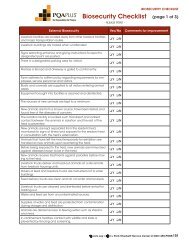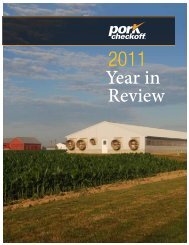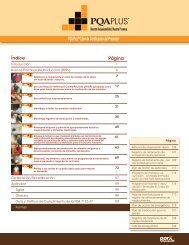PRRS Compendium Producer Edition - National Pork Board
PRRS Compendium Producer Edition - National Pork Board
PRRS Compendium Producer Edition - National Pork Board
Create successful ePaper yourself
Turn your PDF publications into a flip-book with our unique Google optimized e-Paper software.
virus under various conditions of temperature and pH as measured by virus half-life. A half-life is the time<br />
required for the virus population to decline by one-half. Measuring inactivation as half-lifes, rather than<br />
absolute numbers, makes comparisons of different treatments and experiments easy. The calculation of<br />
half-lives and half-life confidence intervals is described elsewhere (Bryan et al., 1990). As shown in Table 1,<br />
under the conditions of the study, inactivation of virus was highly dependent upon both temperature and<br />
pH.<br />
Pirtle and Beran (1996) studied the stability of <strong>PRRS</strong> virus in or on 16 fomites, including plastic, stainless<br />
steel, rubber, alfalfa, wood shavings, straw, corn, swine starter feed, denim cloth, phosphate buffered saline,<br />
well water, city water, swine saliva, urine, and fecal slurry. At 25° to 27°C (77° to 81°F), infectious virus<br />
was not detected on fomites beyond day zero. However, infectious virus was detected in phosphate buffered<br />
saline through day 3, well water through day 8, and city water through day 11.<br />
Disinfection<br />
Effective disinfection first requires removal of all organic material. Thereafter, infectious agents are inactivated<br />
in a temperature- and contact time-dependent fashion specific to the agent and the disinfectant. At<br />
“room temperature,” Shirai et al. (2000) reported complete inactivation of <strong>PRRS</strong> virus with chlorine (0.03%)<br />
in 10 minutes, iodine (0.0075%) in one minute, and a quaternary ammonium compound (0.0063%) in one<br />
minute. The effects of temperature or pH were not explored. Given that <strong>PRRS</strong> virus is relatively fragile in<br />
the environment (Pirtle and Beran, 1996), standard protocols for cleaning and disinfecting facilities should<br />
be effective in the control of <strong>PRRS</strong> virus.<br />
Summary<br />
<strong>PRRS</strong> virus is found in most areas of the world. Within infected countries, 60-80% of herds (prevalence)<br />
are typically infected. Estimates of prevalence are confounded by the use of MLV vaccines in most parts of<br />
the world. MLV vaccines have been available since 1994 and antibodies against vaccine virus are not easily<br />
differentiated from antibodies against <strong>PRRS</strong> virus field strains. Population density has a marked effect<br />
on the prevalence of <strong>PRRS</strong> within herds and regions. Even within the same area, larger herds tend to have<br />
higher in-herd prevalence than smaller herds.<br />
Swine are susceptible to <strong>PRRS</strong> virus by several routes of exposure, including intranasal, intramuscular,<br />
oral, and vaginal. Exposure to 10 or fewer <strong>PRRS</strong> virus particles by intranasal and intramuscular routes<br />
results in infection (Yoon et al., 1999). Benfield et al. (2000a) determined that a <strong>PRRS</strong> virus concentration<br />
of 2x10 3 TCID 50 per 50ml of semen was sufficient to infect females through artificial insemination. The minimum<br />
infectious dose by oral exposure has not been established.<br />
Infection of susceptible animals results in the shedding of virus in saliva, nasal secretions, urine, semen,<br />
and perhaps feces, with shedding occurring simultaneously from many sites at low levels or perhaps intermittently.<br />
Pregnant susceptible females inoculated in late gestation have been shown to shed virus in<br />
mammary secretions (Wagstrom et al. 2001). The infection is a chronic, persistent infection whereby virus<br />
replicates in susceptible cells of infected individuals for several months. Shedding of <strong>PRRS</strong> virus in secretions<br />
and excretions results in environmental contamination and creates the potential for transmission<br />
via fomites. The virus is relatively labile in the environment and is quickly inactivated by drying, but it can<br />
remain infectious for an extended time under specific conditions of temperature, moisture, and pH. ee<br />
et al. (2002a, 2002b) illustrated that <strong>PRRS</strong> virus could be moved extensively on fomites in the field under<br />
winter conditions, i.e., below 0°C (32°F), but to a much lesser degree during warm weather, i.e., 10°-16°C<br />
(50°-61°F). Standard disinfection and sanitation procedures are effective against the virus, but they must<br />
be correctly applied.<br />
<strong>PRRS</strong> virus transmission most commonly occurs by direct transmission, i.e., close contact between animals<br />
or by exposure to contaminated body fluids (semen, virus-tainted blood, or perhaps mammary secretions).<br />
The behavior associated with establishing a social order within a group that involves slashes or<br />
bites in the shoulders, neck, and head and results in the exchange of blood and saliva and transmission of<br />
<strong>PRRS</strong> virus. Indirect transmission by fomites, vectors, or aerosols may also occur. Of these, transmission<br />
via instruments and medications contaminated with body fluids from <strong>PRRS</strong> virus-infected animals is the<br />
most important. This includes instruments used for ear notching, tail docking, teeth clipping, or tattooing,<br />
as well as needles, syringes, medications, and vaccines. Recent research has shown that flies and mosqui-<br />
PAGE PIG 04-01-09





